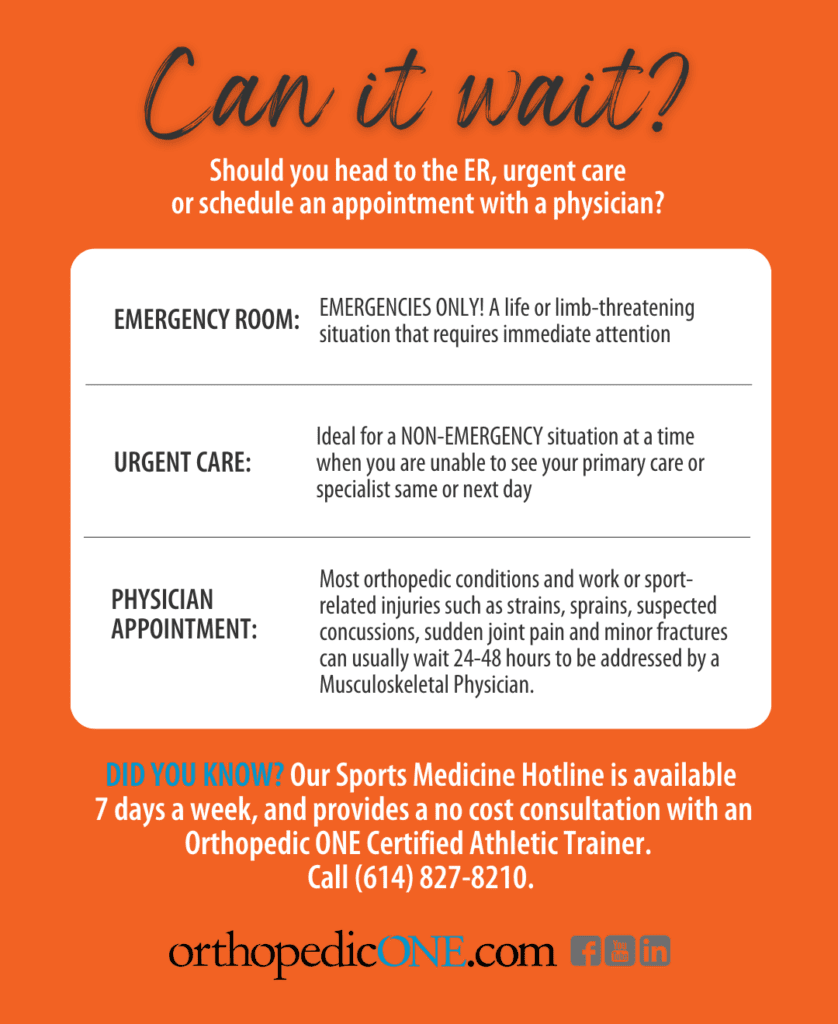CAN IT WAIT?
ER, Urgent Care or Physician Appointment
When sudden injury occurs, a decision must be made. Should you head to the ER, urgent care or schedule an appointment with a physician?
Emergency rooms and urgent care centers are great resources in certain situations. But how do you know when you really need to visit them – and for what types of conditions?
Did you know that the majority of orthopedic injuries and conditions don’t require a trip to the ER or urgent care? In fact, these trips can sometimes end up costing you more time and money – and expose you and your loved ones unnecessarily to illness. And in most cases, will end with a referral to an orthopedic specialist for further evaluation and treatment.
So, how do you know where to go – and when?

Urgent Care Centers are ideal for non-emergency situations that occur when you are unable to schedule an appointment with your primary or specialist physician the same or next day. Most urgent care centers are available in the evenings and weekends to care for you. Typical conditions appropriate for an urgent care setting include minor cuts or wounds requiring stitches.
Emergency Rooms are just that – designed for EMERGENCY situations. If you have a life or limb-threatening condition or injury, you should immediately call 911 or head to your nearest ER. This may include major cuts or wounds that require stitches, serious head trauma or worsening of concussion symptoms, severe bleeding or open/compound fractures (where a bone is protruding).
Most orthopedic conditions and sports injuries such as strains, sprains, concussions, sudden joint pain and minor fractures can usually wait 24-48 hours to be addressed by a Musculoskeletal Physician. When you call to request an appointment, Orthopedic ONE schedulers will take into account the urgency of your situation and schedule you accordingly.
Practicing standard home management techniques known as the RICE method can help alleviate pain, reduce swelling and avoid reinjury until your appointment. These techniques include: Rest, Ice, Compression and Elevation.
- Rest the injured area to avoid further injury
- Apply ice or compression to reduce swelling
- Elevate the injured area
In the case of a suspected concussion, the athlete should not return to activity, should immediately begin “brain rest,” and avoid taking any pharmacological agents unless directed by a physician. Learn more about how to spot a concussion and what to do in the moments following.
At full scale orthopedic and sports medicine practices, like Orthopedic ONE, additional resources like our Sports Medicine Hotline are also available to existing patients and sports medicine partners. This service provides a no cost consultation with an Orthopedic ONE Certified Athletic Trainer. Should an appointment with a physician be required, it can be made by the athletic trainer taking into account the seriousness of the injury.
If you have experienced an orthopedic or sports injury that does NOT require urgent or emergency attention, the team at Orthopedic ONE can help! Find a location near you.